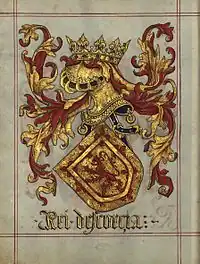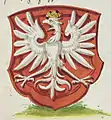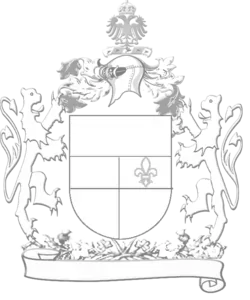Gules
In heraldry, gules (/ˈɡjuːlz/) is the tincture with the colour red. It is one of the class of five dark tinctures called "colours", the others being azure (blue), sable (black), vert (green) and purpure (purple).
| Gules | |
|---|---|
| Class | Colour |
| Non-heraldic equivalent | Red |
| Monochromatic designations | |
| Hatching pattern | |
| Tricking abbr. | g., gu. |
| Poetic designations | |
| Heavenly body | Mars |
| Jewel | Ruby |
Gules is portrayed in heraldic hatching by vertical lines, or indicated by the abbreviation g. or gu. when a coat of arms is tricked.
Etymology
The term gules derives from the Middle English goules, which itself is an Old French word meaning "neckpiece made of red fur". Goules is derived from the Old French gole or guele, both of which mean "throat", which are ultimately derived from the Latin gula, also meaning "throat". Gules is similar to the English word gullet.[1][2] A. C. Fox-Davies states that the term originates from the Persian word گل gol, meaning "rose",[3] but according to Brault there is no evidence to support this derivation.[4]
Poetic meanings
Centuries ago, arms were often described poetically and the tinctures were associated with different gemstones, flowers and heavenly bodies. Gules usually represented the following:
Examples

1. The lion of Nassau, Azure billetty or, a lion rampant of the last armed and langued gules;
2. County of Katzenelnbogen, Or a lion rampant guardant gules, armed langued and crowned azure;
3. County of Vianden, Gules, a fess argent;
4. County of Dietz, Gules, two lions passants or armed and langued azure
Gules is the most widely used heraldic tincture. Through the sixteenth century, nearly half of all noble coats of arms in Poland had a field gules with one or more argent charges on them.
Examples of coats of arms consisting of purely a red shield (blazoned gules plain) include those of the d'Albret family, the Rossi family, the Swiss canton of Schwyz (prior to 1815), and the old coats of arms of the cities of Nîmes and Montpellier.
.jpg.webp) The Plantagenet coat of arms, gules three lions passants guardants or, origin of the Royal Arms of England[6]
The Plantagenet coat of arms, gules three lions passants guardants or, origin of the Royal Arms of England[6] Coat of arms of the House of Savoy, gules a cross argent[7]
Coat of arms of the House of Savoy, gules a cross argent[7] The Royal Arms of Scotland Or a lion rampant Gules within a double tressure flory-counter-flory of the second[8]
The Royal Arms of Scotland Or a lion rampant Gules within a double tressure flory-counter-flory of the second[8] Coat of arms of Schwyz (stained glass, 1573), gules plain; the Juliusbanner with the Arma Christi inset is held by one of the supporters.
Coat of arms of Schwyz (stained glass, 1573), gules plain; the Juliusbanner with the Arma Christi inset is held by one of the supporters. The Austrian Bindenschild, gules a fess argent, originally the Babenberg coat of arms. Below the Bindenschild is a small coat of arms of the city of Vienna, gules a cross argent [9]
The Austrian Bindenschild, gules a fess argent, originally the Babenberg coat of arms. Below the Bindenschild is a small coat of arms of the city of Vienna, gules a cross argent [9] Coat of arms of the Kingdom of Poland, Gules, an eagle argent, crowned or[10]
Coat of arms of the Kingdom of Poland, Gules, an eagle argent, crowned or[10] Coat of arms of French Maison d'Albret. Gueules plain by contemporary heraldic artist Dario Scaricamazza.
Coat of arms of French Maison d'Albret. Gueules plain by contemporary heraldic artist Dario Scaricamazza.
See also
References
- Harper, Douglas. "gules". Online Etymology Dictionary.
- "Definition of GULES".
- A Complete Guide to Heraldry, by Arthur Charles Fox-Davies, p. 29
- Brault, Gerard J. (1997). Early Blazon: Heraldic Terminology in the Twelfth and Thirteenth Centuries, (2nd ed.). Woodbridge, UK: The Boydell Press. ISBN 0-85115-711-4.
- Parker, James (1894). A Glossary of Terms Used in Heraldry. Oxford: Oxford University Press.
- Historia Anglorum c. 1250
- Chillon Castle, c. 1500
- Livro de Armerio-Mor, c. 1509
- Stained glass at the Franciscan Monastery Museum in Villingen-Schwenningen, 1567
- Chorographia Württemberg, 1591, attributed to Casimir III the Great
External links
 Media related to Gules at Wikimedia Commons
Media related to Gules at Wikimedia Commons
